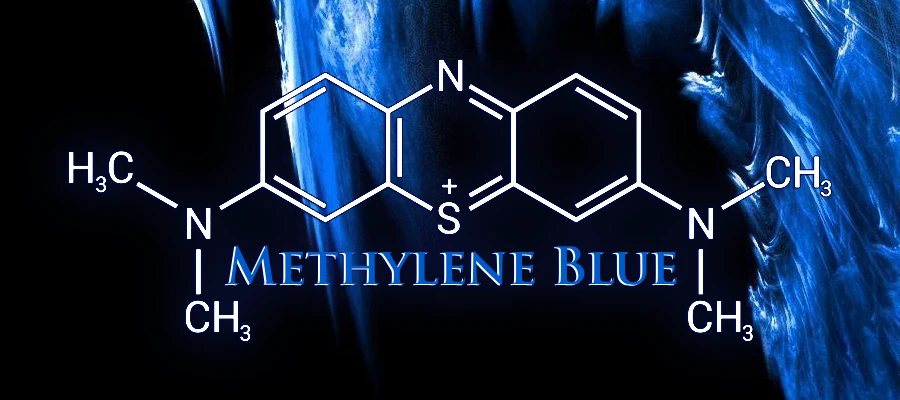What’s the Deal with Methylene Blue?
This article comes at the request of several readers, because once again, we see an old and reliable treatment in the news, being ridiculed as pseudo-science or dangerous. Why? Probably so that you will fear it and turn to some newer and more costly treatment. How many times must we see this before we ignore the effort? Knowledge changes perceptions, so let’s discuss Methylene Blue.
Methylene Blue is a synthetic chemical compound first synthesized in 1876. It’s recognized primarily as a vivid blue dye with numerous applications across both industrial and medical fields. Structurally, it belongs to a class of compounds known as phenothiazines (antipsychotic medications), characterized by their potent oxidizing and reducing capabilities. Despite its early medicinal prominence, Methylene Blue largely faded from the mainstream medical narrative over time, only recently regaining attention for its extensive therapeutic potential. Learn more here.
Medical and Health Applications of Methylene Blue
Methylene Blue was initially embraced in medicine for treating methemoglobinemia, a potentially life-threatening condition where blood loses its oxygen-carrying ability. Its efficacy in rapidly restoring normal oxygen transport to tissues has been extensively documented and remains the standard emergency treatment for this condition. Of course, this opens the door to all sorts of possibilities, but I digress.
In recent years, medical research has expanded significantly, uncovering Methylene Blue’s benefits in things like neurological health. Studies indicate that it might enhance mitochondrial function and cognitive performance, making it a promising candidate for conditions like Alzheimer’s disease, dementia, and traumatic brain injuries. Its neuroprotective properties, which are achieved by improving cellular energy production and reducing oxidative stress, continue to attract scientific interest and user demand.
Lesser-Known Uses and Benefits
Beyond the conventional scope, Methylene Blue has also shown promising outcomes in treating a variety of lesser-known health concerns. Research has explored its potent antimicrobial activity against pathogens such as bacteria, fungi, and viruses. In fact, if you ever see a baby with a blue mouth, that might indicate that the parent is treating the child for thrush using Methylene Blue. Of course, this property has led to its occasional use in managing infections that resist conventional antibiotics.
As mentioned, Methylene Blue demonstrates intriguing psychiatric implications. Preliminary research suggests it may alleviate depression and anxiety, likely due to its effects on neurotransmitter pathways and mitochondrial efficiency. Moreover, its potential anti-aging and longevity benefits, supported by its antioxidative and metabolic-enhancing characteristics, offer another intriguing avenue for further exploration.
Why Methylene Blue Works So Effectively
The effectiveness of Methylene Blue lies fundamentally in its dual antioxidant and metabolic properties. It easily crosses cell membranes, rapidly entering mitochondria (the energy powerhouses of cells), where it enhances oxidative phosphorylation (essential to the processes of both anaerobic and aerobic respiration). By optimizing mitochondrial function and ATP production, it significantly boosts cellular energy availability, improving overall cell vitality and resilience.
Methylene Blue also exhibits powerful redox properties, capable of neutralizing harmful free radicals and reducing oxidative stress, thus protecting cellular structures from damage. These mechanisms collectively explain its broad spectrum of therapeutic efficacy, ranging from critical emergency interventions to subtle neuroprotective benefits. Sounds great, right?
Resistance from Establishment Medicine
Despite a robust history and solid scientific backing, mainstream medicine often marginalizes Methylene Blue due to several factors. I would argue that the first factor is simple… its patent-free status reduces its commercial appeal for pharmaceutical companies, limiting financial incentives for comprehensive clinical trials and widespread promotion. Hence, something that works well is often ignored because physicians are either ignorant of the benefits, don’t like the mess of it, or are pushing something else.
Moreover, institutional inertia and skepticism toward older, repurposed medications further impede its broader acceptance. We see this a lot with older, highly effective remedies and treatments. Similarly, concerns regarding proper dosing, purity, and quality assurance also contribute to hesitance among conventional practitioners, particularly when navigating unfamiliar treatment landscapes.
Side Effects? Not So Fast!
Now, if you do some research on this topic, you will likely find the ‘dark side’ of this substance. Don’t succumb to the scare tactics. Sure, Methylene Blue is frequently viewed cautiously due to concerns about side effects. However, such concerns are typically exaggerated or associated with highly improper use.
The truth is that, at appropriate therapeutic doses, Methylene Blue is remarkably safe. Common mild side effects, such as blue-colored urine, temporary mouth discoloration, or minor gastrointestinal discomfort, are generally harmless and transient. Remember that this stuff is often used with babies and has been used for over a hundred years!
Serious adverse reactions are very uncommon and usually result from significant overdoses or interactions with certain medications (notably, serotonergic drugs). Responsible, informed use significantly mitigates such risks. Of course, this is true regardless of the substance, which prompts me to reiterate the importance of accurate dosing and quality sourcing with anything you put in your body.
Finding Methylene Blue Today
Today, Methylene Blue is where it has always been… including compounding pharmacies, specialized health stores, and online vendors. Yes, ensuring pharmaceutical-grade purity is crucial for therapeutic effectiveness and safety. No, it’s not expensive. Of course, consumers seeking Methylene Blue for therapeutic use should prioritize reputable sources offering verified quality and dosage guidelines.
Final Thoughts
Methylene Blue is another one of those compelling examples of a historically significant yet underutilized medical tool. Through renewed scientific attention and careful, informed use, its therapeutic potential can be fully realized. Ignore unfounded skepticism and misinformation. This is one of those powerhouses that people need to be aware of, because healthcare providers and patients alike can benefit greatly from integrating Methylene Blue into thoughtful and evidence-based therapeutic strategies.
On a personal note, I can tell you that the first time I used it was in 1999. My perception was that it worked great and worked quickly. I’m still here. Of course, the rumors about the stains were true, but the relief I gained from the substance far outweighed any temporary staining issues.
If you would like to learn more, be sure to check out The Persistence of Outdated Medical Knowledge
Want to shop for Methylene Blue? Check out these options at Amazon: Methylene Blue Options
Dr. Robertson is a health researcher and educator, not a physician. The information provided here is not medical advice, a professional diagnosis, opinion, treatment, or service to you or any other individual. The information provided is for educational and anecdotal purposes only and is not a substitute for medical or professional care. You should not use the information in place of a visit, call, consultation, or the advice of your physician or other healthcare providers. Dr. Robertson is not liable or responsible for any advice, course of treatment, diagnosis, or additional information, services, or products you obtain or utilize. IF YOU BELIEVE YOU HAVE A MEDICAL EMERGENCY, YOU SHOULD IMMEDIATELY CALL 911 OR YOUR PHYSICIAN.




